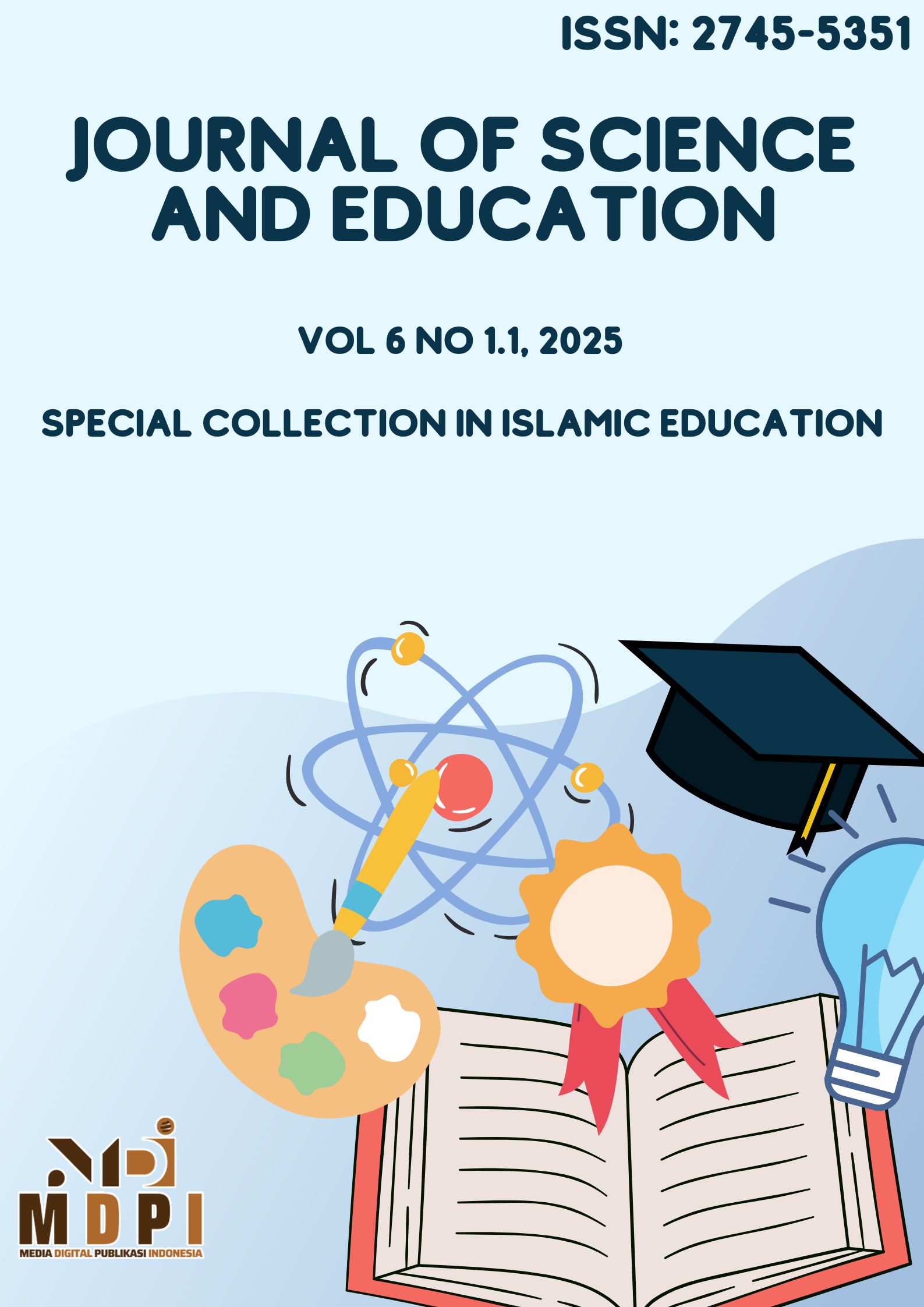The Contribution of Majelis Munadhoroh wal Maktabah (M3) to Improving the Learning Motivation of Islamic Boarding School Students
DOI:
https://doi.org/10.58905/jse.v6i1.1.622Keywords:
Islamic boarding school, Majelis Munadhoroh wal Maktabah, learning motivation, kitab kuning literacy, character education, blended learningAbstract
This study examines the contribution of Majelis Munadhoroh wal Maktabah (M3) to improving the learning motivation of students in Islamic boarding schools, focusing on its implementation at Pondok Pesantren Syaichona Moh. Cholil Bangkalan. Using a qualitative case study approach, the research involved M3 program coordinators, teachers, and actively participating students. Data were collected through participatory observation, in-depth interviews, and document analysis, and were analyzed using the interactive model of Miles, Huberman, and Saldaña. The findings indicate that M3 enhances both intrinsic and extrinsic motivation through active participation, structured classical text (kitab kuning) literacy development, and the cultivation of Islamic values such as humility (tawadhu’) and brotherhood (ukhuwah). Supporting factors include comprehensive library facilities, the STAISyaichona e-Resource digital platform, conducive learning spaces, and strong institutional support. However, sustaining M3’s impact requires consistent facilitation quality, digital literacy training, and continued stakeholder collaboration. The study concludes that M3 represents a hybrid educational model that preserves traditional pesantren scholarship while integrating modern learning innovations, making it a replicable framework for enhancing student motivation in Islamic education.
Downloads
References
M. A. Firdaus, S. Badriah, B. S. Arifin, and A. Hasanah, “Pengembangan Model Pengelolaan Pendidikan Karakter di Pesantren Berbasis Tradisi dan Tadzkiroh,” J. Basicedu, vol. 6, no. 5, pp. 8163–8174, 2022.
M. A. Firdaus and R. Fauzian, Pendidikan Akhlak Karimah Berbasis Kultur Kepesantrenan, vol. 1. Bandung: CV Alfabeta, 2018.
M. M. Van Bruinessen, “Pesantren and kitab kuning: Continuity and change in a tradition of religious learning,” 1994.
M. Arif, R. Nasir, and M. A. Ma’arif, “The Kitab Kuning Learning Model in the Development of Student Expertise in Pesantren-Based Higher Education,” Nazhruna J. Pendidik. Islam, vol. 8, no. 1, pp. 52–74, 2025.
A. N. Irsyadi, M. H. Rosyidi, and Y. D. Agustina, “The Challenge of Mastering Arabic Language and Its Relation to the Ability to Read Kitab Kuning among Students in Tapal Kuda Islamic Boarding School,” RETORIKA J. Ilmu Bhs., vol. 10, no. 3, pp. 825–838, 2024.
E. L. Deci and R. M. Ryan, “Self-determination theory,” Handb. Theor. Soc. Psychol., vol. 1, no. 20, pp. 416–436, 2012.
A. Fahruroji, “Pembelajaran Era Digital (Studi di Pondok Pesantren Kun Karima Kabupaten Pandeglang),” Aksioma Ad Diniyah Indones. J. Islam. Stud., vol. 9, no. 1, 2021.
R. N. Syaifudin, “Kiai Kampung Dan Tantangan Era Digital: Upaya Penguatan Karakter Dan Motivasi Belajar Pemuda,” Althanshia J. Pendidik. Agama Islam, vol. 2, no. 2, pp. 11–21, 2024.
S. Arifin, “Dinamika Kepemimpinan Pondok Pesantren,” FIKROTUNA J. Pendidik. dan Manaj. Islam, vol. 4, no. 2, 2016, doi: 10.32806/jf.v4i2.2751.
M. Ulfa, “Metode Sorogan Kitab untuk Pemahaman Nahwu (Imrity) Pondok Pesantren Assunniyah Kencong Jember,” Al-Fathin J. Bhs. dan Sastra Arab, vol. 5, no. 01, pp. 65–82, 2022.
E. Firmansyah, T. Tobroni, A. A. Lasawali, and A. M. A. Marhum, “MERANGKAI PERKEMBANGAN LEMBAGA PENDIDIKAN PESANTREN DAN USAHANYA DALAM MELAHIRKAN TOKOH-TOKOH TERBAIK BANGSA,” Res. Dev. J. Educ., vol. 8, no. 2, pp. 702–706, 2022, doi: 10.30998/rdje.v8i2.13770.
M. Sirojuddin and A. Yaqin, “Integrating Heutagogy and Self-efficacy: Study on Bahtsul Masail-based Learning Design,” J. Pesantren Diniyah Stud., vol. 1, no. 2, pp. 151–164, 2024.
C. Kaya and A. Nazarov, “The Influence of Reward and Punishment Systems on Student Discipline,” Int. J. Educ. Narrat., vol. 3, no. 2, pp. 175–183, 2025.
J. W. Creswell and V. L. P. Clark, Designing and conducting mixed methods research. Sage publications, 2017.
Adrias and A. Ruswandi, Desain Penelitian Kuantitatif, Kualitatif, dan Mix Method. Depok: Rajawali Pers, 2025.
R. K. Yin, Case study research and applications. SAGE Publications US., 2017.
M. Q. Patton, Qualitative research & evaluation methods: Integrating theory and practice. Sage publications, 2014.
A. Tashakkori and J. W. Creswell, “The new era of mixed methods,” J. Mix. Methods Res., vol. 1, no. 1, pp. 3–7, 2007, doi: 10.1177/2345678906293042.
Y. Lincoln and B. Guba, “Naturalistic inquiry. Beverly Hills: Sage Pulications.” Inc, 1985.
E. J. Tisdell, S. B. Merriam, and H. L. Stuckey-Peyrot, Qualitative research: A guide to design and implementation. John Wiley & Sons, 2025.
A. K. Shenton, “Strategies for ensuring trustworthiness in qualitative research projects,” Educ. Inf., vol. 22, no. 2, pp. 63–75, 2004.
M. B. Miles, A. M. Huberman, and J. Saldana, Qualitative Data Analysis A Methods Sourcebook, Third Edit. United States of America: SAGE Publications, Inc., 2014.
C. C. Bonwell and J. A. Eison, Active learning: Creating excitement in the classroom. 1991 ASHE-ERIC higher education reports. ERIC, 1991.
M. Weimer, Learner-centered teaching: Five key changes to practice. John Wiley & Sons, 2013.
M. Zed, Metode penelitian kepustakaan. Yayasan Pustaka Obor Indonesia, 2008.
P. Freire, Pedagogy of indignation. Routledge, 2015.
B. M. Bass and R. E. Riggio, Transformational leadership: Second edition. 2005.
M. Tubagus, H. Haerudin, A. Fathurohman, A. Adiyono, and A. Aslan, “The impact of technology on islamic pesantren education and the learning outcomes of santri: new trends and possibilities,” Indones. J. Educ., vol. 3, no. 3, pp. 443–450, 2023.
J. W. Gikandi, D. Morrow, and N. E. Davis, “Online formative assessment in higher education: A review of the literature,” Comput. Educ., vol. 57, no. 4, pp. 2333–2351, 2011, doi: 10.1016/j.compedu.2011.06.004.
A. Aviram and Y. Eshet-Alkalai, “Towards a theory of digital literacy: Three scenarios for the next steps,” Eur. J. Open, Distance E-Learning, vol. 9, no. 1, 2006.
P. Glewwe and K. Muralidharan, “Improving School Education Outcomes in Developing Countries,” 2022.
Downloads
Published
How to Cite
Issue
Section
License
Copyright (c) 2025 S Salman, Wiwik Dyah Andayani

This work is licensed under a Creative Commons Attribution-ShareAlike 4.0 International License.

















